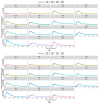Machine Learning and Pharmacometrics for Prediction of Pharmacokinetic Data: Differences, Similarities and Challenges Illustrated with Rifampicin
- PMID: 35893785
- PMCID: PMC9330804
- DOI: 10.3390/pharmaceutics14081530
Machine Learning and Pharmacometrics for Prediction of Pharmacokinetic Data: Differences, Similarities and Challenges Illustrated with Rifampicin
Abstract
Pharmacometrics (PM) and machine learning (ML) are both valuable for drug development to characterize pharmacokinetics (PK) and pharmacodynamics (PD). Pharmacokinetic/pharmacodynamic (PKPD) analysis using PM provides mechanistic insight into biological processes but is time- and labor-intensive. In contrast, ML models are much quicker trained, but offer less mechanistic insights. The opportunity of using ML predictions of drug PK as input for a PKPD model could strongly accelerate analysis efforts. Here exemplified by rifampicin, a widely used antibiotic, we explore the ability of different ML algorithms to predict drug PK. Based on simulated data, we trained linear regressions (LASSO), Gradient Boosting Machines, XGBoost and Random Forest to predict the plasma concentration-time series and rifampicin area under the concentration-versus-time curve from 0-24 h (AUC0-24h) after repeated dosing. XGBoost performed best for prediction of the entire PK series (R2: 0.84, root mean square error (RMSE): 6.9 mg/L, mean absolute error (MAE): 4.0 mg/L) for the scenario with the largest data size. For AUC0-24h prediction, LASSO showed the highest performance (R2: 0.97, RMSE: 29.1 h·mg/L, MAE: 18.8 h·mg/L). Increasing the number of plasma concentrations per patient (0, 2 or 6 concentrations per occasion) improved model performance. For example, for AUC0-24h prediction using LASSO, the R2 was 0.41, 0.69 and 0.97 when using predictors only (no plasma concentrations), 2 or 6 plasma concentrations per occasion as input, respectively. Run times for the ML models ranged from 1.0 s to 8 min, while the run time for the PM model was more than 3 h. Furthermore, building a PM model is more time- and labor-intensive compared with ML. ML predictions of drug PK could thus be used as input into a PKPD model, enabling time-efficient analysis.
Keywords: feature selection; machine learning; pharmacokinetics; pharmacometrics; population pharmacokinetics; rifampicin; simulation.
Conflict of interest statement
Conflict of interest applicable to GSK authors: G.M.E. and G.V. are employed by GlaxoSmithKline, Uxbridge, Middlesex, UK. The views and opinions presented in this manuscript do not reflect the company’s position. The authors declare no conflict of interest.
Figures














References
-
- Meibohm B., Derendorf H. Basic concepts of pharmacokinetic/pharmacodynamic (PK/PD) modelling. Int. J. Clin. Pharmacol. Ther. 1997;35:401–413. - PubMed
Grants and funding
LinkOut - more resources
Full Text Sources

